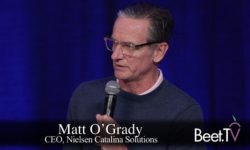SAN JUAN — It is the technology that can laser-target an ad at individual TV viewers or households, and then control how many more ads get seen across TV and other media. But what is the state of “addressable” television?
A Beet Retreat panel convened by Beet.TV in Puerto Rico discussed that topic.
Slow addressable adoption?
The debate kicked off with some data points quantifying the size of spend in US addressable TV advertising today…
Howard Shimmel, President, Janus Strategy and Insights, LLC:
“Two percent of all national media (is) being spent via addressable. Forester issued some research last summer that said about 15% of advertisers are using advanced TV, (but) 50% are sitting on the sidelines. Are you happy with the level of adoption? Are we behind?”
Mike Bologna, President, one-2-one media, Cadent:
“For the advertisers where the return outweighs the work and the pain, they’re involved. For the advertisers and the brands where it doesn’t, they’re not there.
Brands only dipping a toe
Whilst media buyers are certainly spending in addressable TV, executives bemoaned that the budget was still experimental or occasional…
Michael Law, EVP, US Media Investment, Dentsu Aegis Network:
“Our (clients’) spend is actually about flattened down a little. But the number of brands interacting is growing because we’ve had some brands who went in just way too high early on. What is worrisome is the amount of (spending that) is still considered ‘test and learn’ – it’s just a little bit of money and then it goes away.”
Mike Bologna, President, one-2-one media, Cadent:
“That’s very true. That is the single biggest issue with scaling the dollars in addressable television today. Many advertisers want to do it for the wrong reasons. They want to check off the ‘innovation’ box.”
More supply needed
Panelists discussed how limiting the availability of inventory with the right audiences against it could actually work against addressable…
Mike Bologna, President, one-2-one media, Cadent:
“Historically, television has always been (about) supply and demand. When the supply decreases, the knee jerk reaction is to raise the price. As we all know, in television, at least in recent times, the advertisers still stand in line with the checkbook.
“That’s not going to work with addressable television. If we run out of inventory, or we get to a point where there’s a finite supply of inventory, it’s going to drive up the price.”
Craig Berkley, Head of Revenue, TV, LiveRamp:
“You’re going to have ownership of programmers by MVPDs or at least a fusion of the two. That inventory will open up and I think OTT is also growing rapidly.”
Don’t target, cap
The debate heard one view that addressability should not be about targeting audiences at all – especially for certain brands…
Adam Gerber, President, Global Media Investment, Essence (GroupM):
“We’re thinking about addressability wrong … The math is not going to work, right? I would question, are we thinking about addressability the right way as being about audiences? Or should we be thinking about it a different way, in that it can solve frequency distribution? The better option for us is, how do we use addressability to manage frequency, not target audiences.”
Michael Law, EVP, US Media Investment, Dentsu Aegis Network:
“Right now, there’s a lot of categories saying, “How do I (target) toilet paper (which everyone needs)?”
Solve for cord-cutting
But the panel also heard how addressable or some alternative to conventional linear TV advertising is essential…
Jonathan Steuer, Chief Research Officer, Omnicom Media Group:
“Part of the problem now, with the way viewership behavior is shifting, is that there are a lot of people who you’re just never gonna get on linear TV because they don’t do that anymore. Whether it’s linear or addressable, or anything that looks like broadcast, to try to reach people who don’t have an antenna or cable subscription ain’t going to work.”
This video was produced in San Juan, Puerto Rico at the Beet.TV executive retreat. Please find more videos from the series on this page.
The Beet Retreat was presented by NCC along with Amobee, Dish Media, Oath and Google.














































